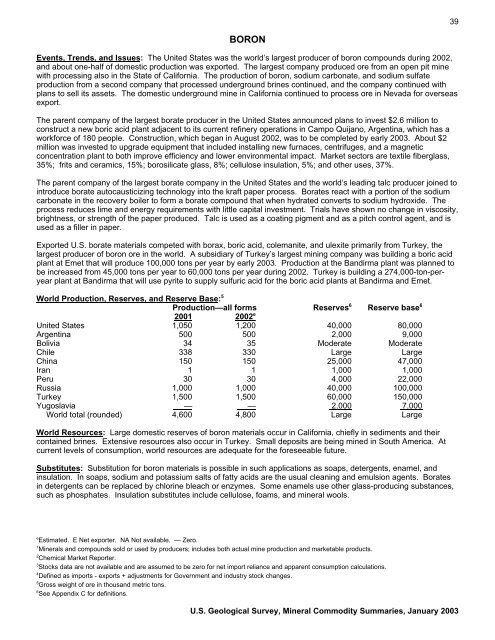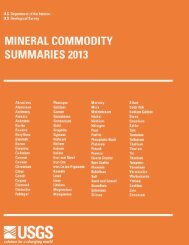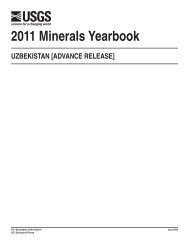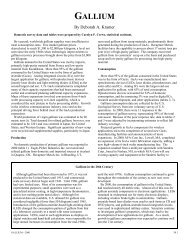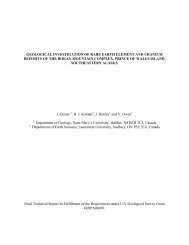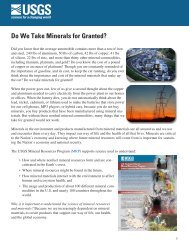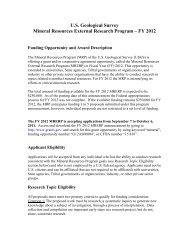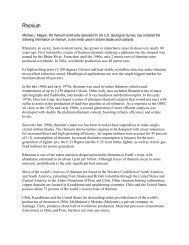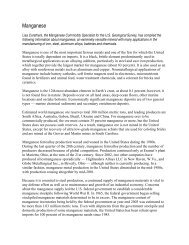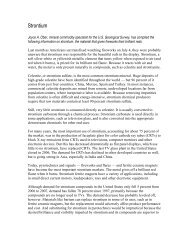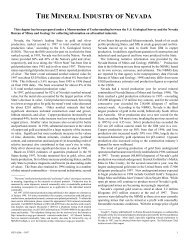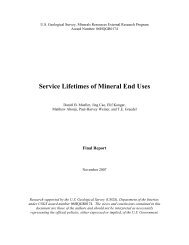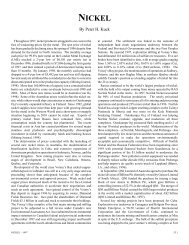Mineral Commodity Summaries 2003 - Mineral Resources Program ...
Mineral Commodity Summaries 2003 - Mineral Resources Program ...
Mineral Commodity Summaries 2003 - Mineral Resources Program ...
You also want an ePaper? Increase the reach of your titles
YUMPU automatically turns print PDFs into web optimized ePapers that Google loves.
BORON<br />
Events, Trends, and Issues: The United States was the world’s largest producer of boron compounds during 2002,<br />
and about one-half of domestic production was exported. The largest company produced ore from an open pit mine<br />
with processing also in the State of California. The production of boron, sodium carbonate, and sodium sulfate<br />
production from a second company that processed underground brines continued, and the company continued with<br />
plans to sell its assets. The domestic underground mine in California continued to process ore in Nevada for overseas<br />
export.<br />
The parent company of the largest borate producer in the United States announced plans to invest $2.6 million to<br />
construct a new boric acid plant adjacent to its current refinery operations in Campo Quijano, Argentina, which has a<br />
workforce of 180 people. Construction, which began in August 2002, was to be completed by early <strong>2003</strong>. About $2<br />
million was invested to upgrade equipment that included installing new furnaces, centrifuges, and a magnetic<br />
concentration plant to both improve efficiency and lower environmental impact. Market sectors are textile fiberglass,<br />
35%; frits and ceramics, 15%; borosilicate glass, 8%; cellulose insulation, 5%; and other uses, 37%.<br />
The parent company of the largest borate company in the United States and the world’s leading talc producer joined to<br />
introduce borate autocausticizing technology into the kraft paper process. Borates react with a portion of the sodium<br />
carbonate in the recovery boiler to form a borate compound that when hydrated converts to sodium hydroxide. The<br />
process reduces lime and energy requirements with little capital investment. Trials have shown no change in viscosity,<br />
brightness, or strength of the paper produced. Talc is used as a coating pigment and as a pitch control agent, and is<br />
used as a filler in paper.<br />
Exported U.S. borate materials competed with borax, boric acid, colemanite, and ulexite primarily from Turkey, the<br />
largest producer of boron ore in the world. A subsidiary of Turkey’s largest mining company was building a boric acid<br />
plant at Emet that will produce 100,000 tons per year by early <strong>2003</strong>. Production at the Bandirma plant was planned to<br />
be increased from 45,000 tons per year to 60,000 tons per year during 2002. Turkey is building a 274,000-ton-peryear<br />
plant at Bandirma that will use pyrite to supply sulfuric acid for the boric acid plants at Bandirma and Emet.<br />
World Production, Reserves, and Reserve Base: 5<br />
Production—all forms Reserves 6<br />
Reserve base 6<br />
2001 2002 e<br />
United States 1,050 1,200 40,000 80,000<br />
Argentina 500 500 2,000 9,000<br />
Bolivia 34 35 Moderate Moderate<br />
Chile 338 330 Large Large<br />
China 150 150 25,000 47,000<br />
Iran 1 1 1,000 1,000<br />
Peru 30 30 4,000 22,000<br />
Russia 1,000 1,000 40,000 100,000<br />
Turkey 1,500 1,500 60,000 150,000<br />
Yugoslavia — — 2,000 7,000<br />
World total (rounded) 4,600 4,800 Large Large<br />
World <strong>Resources</strong>: Large domestic reserves of boron materials occur in California, chiefly in sediments and their<br />
contained brines. Extensive resources also occur in Turkey. Small deposits are being mined in South America. At<br />
current levels of consumption, world resources are adequate for the foreseeable future.<br />
Substitutes: Substitution for boron materials is possible in such applications as soaps, detergents, enamel, and<br />
insulation. In soaps, sodium and potassium salts of fatty acids are the usual cleaning and emulsion agents. Borates<br />
in detergents can be replaced by chlorine bleach or enzymes. Some enamels use other glass-producing substances,<br />
such as phosphates. Insulation substitutes include cellulose, foams, and mineral wools.<br />
e<br />
Estimated. E Net exporter. NA Not available. — Zero.<br />
1<br />
<strong>Mineral</strong>s and compounds sold or used by producers; includes both actual mine production and marketable products.<br />
2<br />
Chemical Market Reporter.<br />
3<br />
Stocks data are not available and are assumed to be zero for net import reliance and apparent consumption calculations.<br />
4 Defined as imports - exports + adjustments for Government and industry stock changes.<br />
5 Gross weight of ore in thousand metric tons.<br />
6 See Appendix C for definitions.<br />
U.S. Geological Survey, <strong>Mineral</strong> <strong>Commodity</strong> <strong>Summaries</strong>, January <strong>2003</strong><br />
39


